Decision Summary
- Budget Model Design Recommendations
-
A PDF copy of the decision summary is available for download here.
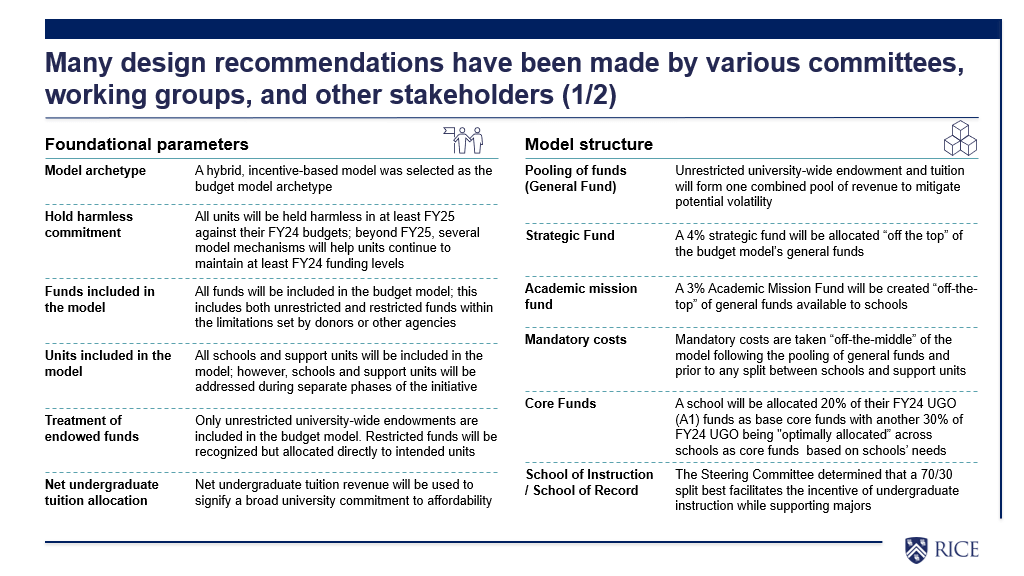
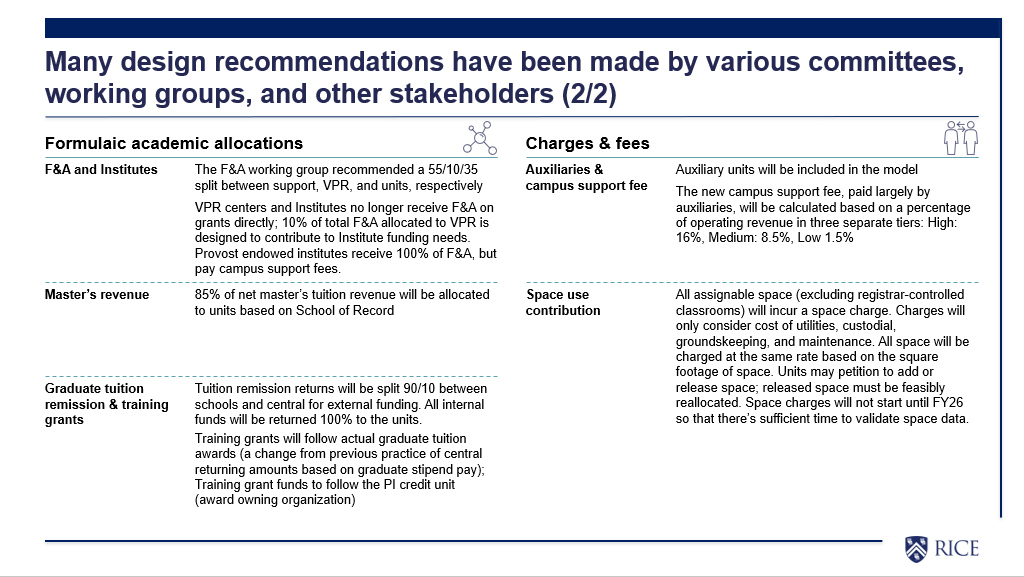
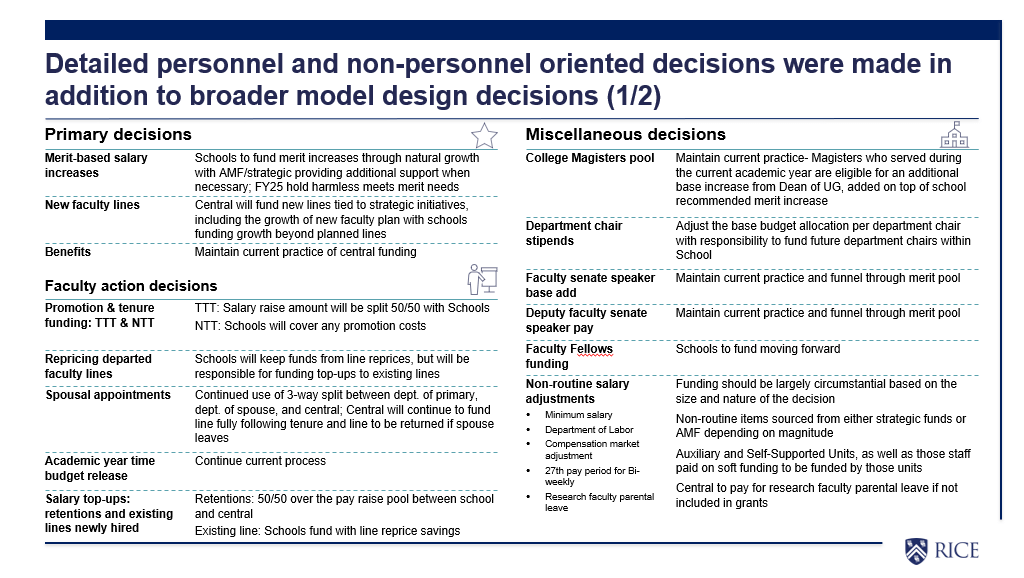
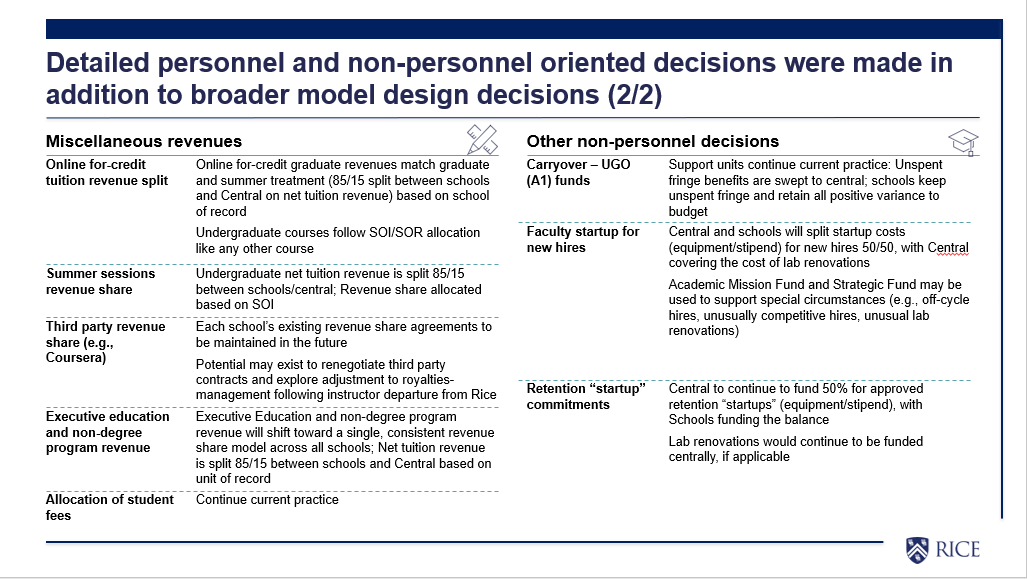
Formulaic Academic Allocations
- F&A and Institutes
-
The working group's recommendation, approved by the Design Committee and Steering Committee, is to split F&A recovery (based on the latest Comptroller, Budget Office, and RCA reporting) 55% to the General Fund (support), 10% to the VPR's office to help fund VPR institutes, and 35% to research generating unit based on PI home school. Institutes that report through the VPR will not directly receive F&A but will pay campus support fees. Please click this link for more details.
Definition Decision Impact Facilities & Administration (F&A) funds are intended to reflect indirect costs associated with research, which are incurred centrally (e.g., facilities costs), by the research generating units (i.e., schools), and by the VP of Research's office (VPR).
F&A returns have historically been allocated between central and schools at a rate of 83% to central and 17% to research-generating units, based on PI reporting.The working group's recommendation, approved by the Design Committee and Steering Committee, is to split F&A recovery (based on the latest Comptroller, Budget Office, and RCA reporting) 55% to the General Fund (support), 10% to the VPR's office to help fund VPR institutes, and 35% to research generating unit based on PO home school. Institutes that report through the VPR will not directly receive F&A but will pay campus support fees.
School allocations will be made to Deans; Deans will decide whether/how to allocate F&A returns to departments and/or PIs. FY23 actuals will be used for FY25 budgets; remaining budgeted funds over and above actuals flow through the General Fund.Doubles F&A returned to schools in an effort to help incentivize research activity in line with the university's goal of doubling research expenditures.
Ensures funds are available to support centrally managed and VPR expenses associated with research activity. - Master's Revenue
-
Please click this link for additional information on the rationale for the 85% allocation.
Definition Decision Impact Master's tuition revenue is typically allocated to revenue-generating schools, with a portion held back as a revenue -share with Central/support functions to cover the university's costs. In our previous incremental model, schools retained 80% of tuition revenue for Master's students, while 20% was shared with Central. Net Master's tuition revenue will all be allocated 85% to schools and 15% to Central (via the General Fund); Master's tuition allocation to schools will be based solely on School of Record (though schools will receive undergraduate instruction credit for Master's student credit hours taken in another school's undergraduate courses). Increased allocation to schools in the new model is intended to provide stronger incentive for schools to expand existing and create new professional Master's programs. - Graduate Tuition Remission & Training Grants
-
Please click this link for details on the Graduate working group recommendations on tuition remission and training grants.
Definition Decision Impact Tuition remission at Rice refers to a charge to a funding source associated with the costs of education for doctoral students; It is an additional percentage charged on amounts paid to graduate students who serve as RAs or TAs and can be generated from research grants or local funds.
Training grants are awards meant to support groups of pre-and/or postdoctoral students training for careers-related research; Historically, training grant allocations have been based on estimated returns to Rice, which has resulted in Central allocating more funds to schools than it received.Tuition remission returns will be split 90/10 between schools and Central for external funding; All internal (local) funds will be returned 100% to the units.
Training grants will shift from being based on actual graduate stipends paid to actual graduate tuition awards with 90/10 split between the award-winning organization and Central.
When students are aligned to interdisciplinary programs housed in the Office of Research, tuition remission will be reduced in the relevant school to help cover the cost of the programs. The reduction of tuition remission is based on the number of students in a program from each school.Adjusting the tuition remission return split between Central and units will simplify allocation calculations; Returning 100% of tuition remission returns from local funds will reduce faculty incentive to misclassify students in order to receive more tuition remission.
The changes to the training grant policy will ensure a more accurate allocation of funds.
The new policy for Office of Research programs will ensure that all related parties are adequately funded to cover their costs associated with supporting graduate students.
Charges and Fees
- Auxiliaries and Campus Support Fee
-
Please click this link for details of the Distributive and Auxiliaries working group recommendations.
Definition Decision Impact The campus support fee is the new name of what was previously called distributive charges. These charges serve as a contribution toward support costs/overhead paid centrally by the university, and are typically paid by non-school revenue-generating units (e.g., auxiliaries, some institutes). Schools that are already contributing to Central via revenue share models do not typically pay these charges.
In the previous model, Rice employed a complex system of 28 types of distributive charges based on ~20 metrics.The new campus support fee will greatly simplify historical distributive charges, and will be calculated based on a percentage of units' operating revenue for auxiliary units and provost endowed institutes. There will be three tiers of campus support fee rates, and units will be assigned a rate based on their historical distributive charge and campus tax contributions. Tiers include: High - 16%, Medium - 8.5%, Low - 1.5%. The new campus support fee structure significantly simplifies distributive charges, increases transparency, and greatly reduces the administrative burden associated with calculating distributive charges while continuing to recoup sufficient funds to cover Central operations. - Space Use Contribution
-
Please click this link for details of the Space Use working group recommendations.
Definition Decision Impact Space is a critical resource at Rice, and one that is costly to maintain. Rice has historically paid all costs associated with physical space (e.g., utilities, maintenance, facilities, interest, insurance) centrally, with only a small portion of units (e.g., auxiliaries, some institutes) contributing toward space costs through distributive charges. A space use contribution provides an opportunity to incentivize efficient use of campus space by requiring units to contribute toward the cost of maintaining they space they occupy. Units are expected to pay higher charges when they take on more space, and to see charges decline when they release space they do not need. All units that do not pay campus support fees (previously known as distributive charges), will pay a space use contribution based on the assignable square feet (ASF) they occupy. Registrar-controlled classrooms will be excluded from the ASF calculation, as will non-assignable space (e.g., bathrooms, hallways).
The contribution will be based on a per square foot dollar amount, which is based on covering the cost of utilities (excluding utilities overhead, e.g., central staff), custodial, groundskeeping, and maintenance; other costs (e.g., interest, deferred maintenance) will be paid centrally. To support simplicity, all space will be charged at the same per sq ft rate (i.e., labs are charged at same rate as offices).
Units may petition to add or release space, which must be released in bundles that can reasonably be reallocated. Space use contributions will be tested “behind the scenes” in FY25, before being incorporated in the model in FY26 to allow sufficient time to validate space data. All units paying space use contributions will receive an up-front allocation in FY26 to cover the cost of their square footage at time of launch—in future years, units will see benefits from releasing space, or additional charges to cover new space.Space contributions are expected to encourage some schools to release classrooms to the registrar, supporting optimal use of instructional space. Units are also expected to reconsider their space needs and ways of working, allowing the university to be more efficient with existing space, avoid unnecessary new construction, and accommodate new needs (e.g., new hires within faculty hiring plan). Where schools petition for new space (at added cost), it is expected that the need will be driven by new revenue sources (e.g., expanded research and F&A, growth of Master’s programs) which help offset the new cost.
Personnel Decisions
- Core Personnel, Faculty Action, and Other Miscellaneous Decisions
-
Please click this link to get detailed decisions on the topics below.
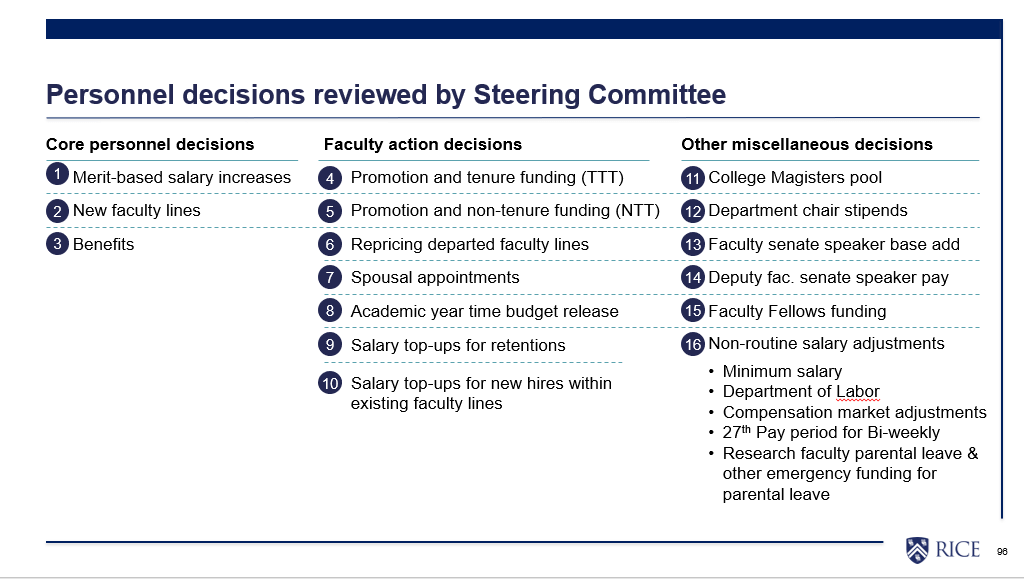
Tririga Billing Processes
- F&CP Service Level Agreement Matrix
-
Please visit the Tririga Billing Processes web page for a list of billable services chargeable to the customer. For additional details relating to non-billable and billable work, please refer to the F&CP Service Level Agreement Matrix.
